To track toll costs before you go, use online toll calculators, official agency websites, or mobile apps to estimate fees for your planned route. Explore maps that highlight toll-free roads or scenic alternatives to save money. Consider toll passes or electronic transponders for easier payment and potential discounts. Also, plan your route to avoid unnecessary tolls, and stay updated on toll policy changes. For more tips on managing costs and optimizing your trip, keep exploring.
Key Takeaways
- Use official toll agency websites and online toll calculators to estimate costs for your planned routes.
- Download and utilize mobile apps that provide real-time toll fee estimates and route optimization features.
- Subscribe to alerts from toll providers to stay informed about fee changes, discounts, and policy updates.
- Consider prepaid toll passes or transponders for seamless payments and accurate toll expense tracking.
- Plan alternative routes avoiding tolls using GPS or online maps to manage costs and stay within budget.
Understanding Tolls and Toll Roads
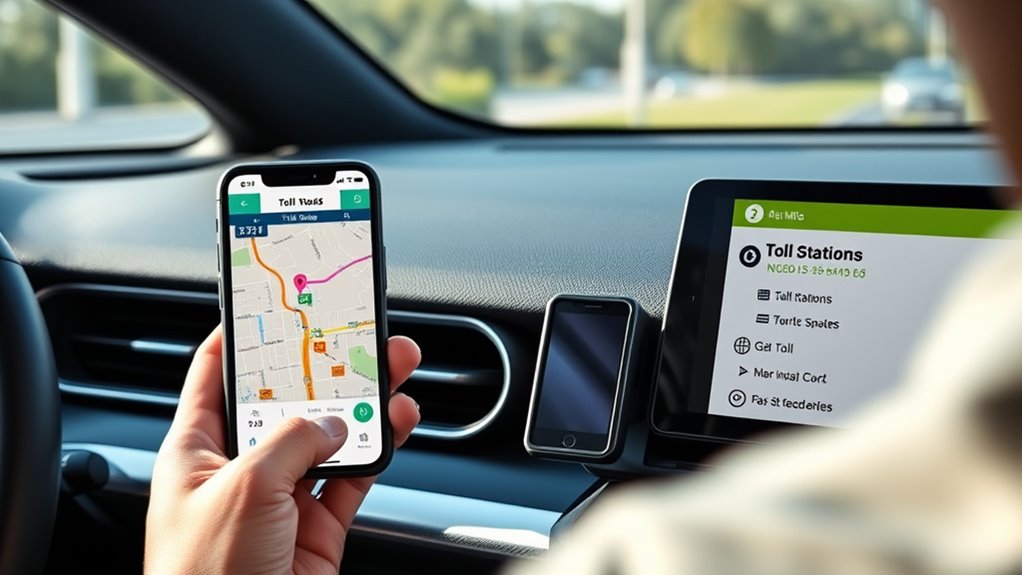
Tolls are fees drivers pay to use certain roads, bridges, or tunnels, often funded for maintenance and improvements. Understanding toll fee policies helps you know when and where you’ll need to pay. These policies vary by location, with some tolls collected electronically and others through cash payments. Toll road maintenance is essential to keep these roads safe and functional, which is why toll fees are collected regularly. Some tolls are variable and change based on the time of day or traffic conditions, so it’s important to stay informed about these policies. By understanding how toll fees are structured, you can plan your routes accordingly, avoid surprises, and better manage your travel budget. Staying aware of toll policies can also help you choose routes that minimize extra expenses and improve your overall travel experience. Additionally, understanding the contrast ratio of toll roads, such as dynamic pricing, can help you anticipate costs during peak times. Being familiar with cost management strategies for tolls allows travelers to make more cost-effective decisions and optimize their trips.
Using Online Toll Calculators and Maps

Online toll calculators and maps are valuable tools that help you estimate toll costs before you hit the road. They provide detailed routes, showing toll fees along your planned path, so you can plan accordingly. These tools often include information about toll fee discounts available for frequent travelers or certain vehicle types, helping you save money. They also update in real-time to reflect toll road construction, which can cause detours or fee adjustments. By using these calculators, you can identify the most cost-effective routes and avoid unexpected charges. Many map services and transportation agency websites offer free access to these resources. Additionally, understanding the role of limits in creativity can inspire innovative route planning and problem-solving when faced with unexpected road conditions. Being aware of privacy and cookie usage can help you manage your data preferences while using these online tools. Recognizing the signs of narcissism can also help you stay aware of manipulative behaviors during interactions on public platforms or social media while planning your trips. Incorporating data-driven strategies into your planning process can further enhance your ability to make informed and efficient decisions. For example, some tools utilize Glycolic Acid Benefits for Skin insights to optimize route choices based on weather or road conditions.
Mobile Apps for Toll Cost Estimation
Mobile apps for toll cost estimation come with a variety of features designed to help you plan your trips more efficiently. You’ll want to take into account their accuracy and reliability to guarantee you get precise cost estimates. Understanding these aspects helps you choose the best app for your toll tracking needs. Additionally, some apps incorporate world clock functionality to help you coordinate travel across different time zones effectively. When selecting an app, consider how well it accounts for Mom – Amazing Life Together to ensure comprehensive trip planning.
App Features Overview
Ever wondered how you can quickly estimate toll costs before hitting the road? Mobile apps for toll cost estimation offer a range of features to help you plan efficiently. These apps often include real-time toll fee discounts, ensuring you get the lowest possible rates. They also alert you to potential toll violation penalties, helping you avoid costly fines. Many apps provide route optimization, showing the most economical paths based on toll costs and discounts. Some even offer integration with payment systems, so you can pay tolls directly through the app. User-friendly interfaces make it easy to input your destination and see detailed toll breakdowns. Additionally, knowledge of Catering and Delivery options can help you optimize your travel plans for better efficiency, further reducing overall travel costs. Overall, these features empower you to manage toll expenses proactively, saving you money and peace of mind before you start your journey.
Accuracy and Reliability
While toll cost estimation apps are valuable tools, their accuracy and reliability can vary depending on several factors. Toll collection methods differ across regions, which can affect how well an app predicts costs. If the app isn’t updated regularly, it might provide outdated toll rates, leading to unexpected toll violations. Inaccurate estimates can result in you underestimating toll expenses or missing tolls altogether, risking fines or penalties. Some apps rely on GPS data, which may not always precisely detect toll roads, especially in complex highway systems. To avoid issues, choose apps known for accurate toll collection data and keep them current. Additionally, regulatory standards in different regions may influence toll pricing and collection methods, impacting app accuracy. Relying on unreliable estimates can cause frustration and additional costs, so verify toll info before your trip when possible. Incorporating industry trends into your planning can help select the most reliable tools for your journey. Moreover, regional variations can significantly affect toll charges, so understanding local toll policies can enhance your planning accuracy. A thorough understanding of electric vehicle technology, including how toll systems interact with EVs, can further improve your trip planning. Furthermore, understanding toll system updates can help you stay informed about recent changes that might impact toll costs and app performance.
Checking State and Regional Toll Agencies
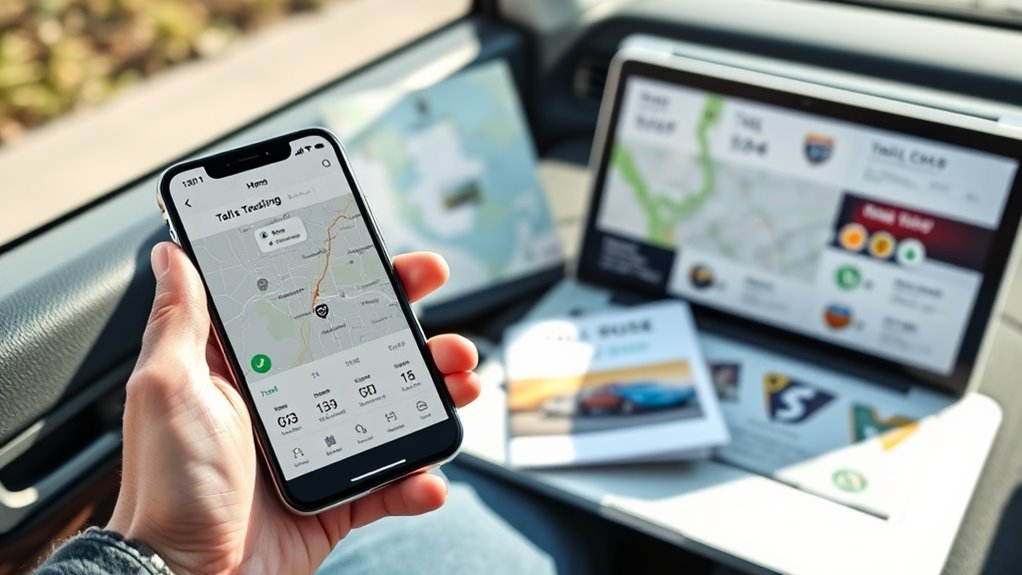
Checking with state and regional toll agencies is the first step to accurately tracking your toll costs. Visit their websites or contact them directly to understand toll fee discounts available, such as low-income or frequent traveler discounts. This helps you plan your budget effectively. It’s also essential to familiarize yourself with toll booth etiquette—like proper lane choices and payment methods—to avoid delays and fines. Keep in mind that different agencies may have varying procedures. Use the following table to compare key features:
| Feature | Details |
|---|---|
| Toll fee discounts | Available for seniors, military, etc. |
| Payment methods | E-ZPass, cash, online billing |
| Toll booth etiquette | Stay in correct lane, follow signage |
| Regional differences | Varying rules and fee structures |
Being informed guarantees smooth travel and accurate toll tracking. Additionally, exploring trailer music techniques can inspire your audio branding and sound design choices during travel-related projects. For comprehensive planning, consider regional toll policies to understand specific regulations and fee variations across different areas. Moreover, reviewing state-specific regulations ensures compliance with local rules and helps avoid unexpected charges. Staying aware of emerging toll technology can further streamline your journey as systems evolve and become more efficient.
Planning Your Route to Minimize Toll Fees

You can save money by mapping out alternative routes that avoid tolls whenever possible. Using toll cost apps helps you compare options quickly and find the most affordable path. Planning ahead guarantees you minimize fees and stay within your budget.
Map Alternative Routes
Have you considered planning your route to avoid tolls altogether? Mapping alternative routes can help you steer clear of toll booth payments and save money. Use online maps or GPS systems that highlight toll-free roads, allowing you to find options offering toll fare discounts or no tolls at all. Sometimes, taking scenic or local roads may add time but considerably reduce costs. Avoid tolls by plotting routes around toll plazas, especially during busy travel times when toll booth payment lines are long. Remember, choosing less direct paths might seem inconvenient, but it can add up to substantial savings. Planning ahead ensures you’re not caught off guard by toll fees, giving you control over your trip’s cost and making your journey more budget-friendly.
Use Toll Cost Apps
Using toll cost apps can make planning your route to minimize toll fees quick and effortless. These apps analyze toll fee policies and suggest routes that reduce costs, helping you save money on your trip. They often highlight options with toll fee discounts or less expensive toll plazas. To get the most out of these apps, consider these features:
- Compare toll costs across different routes to find the cheapest option.
- Check for toll fee discounts available for specific vehicle types or time periods.
- Review real-time updates on toll fee policies that may affect your route.
Estimating Costs for Commercial Vehicles and RVs
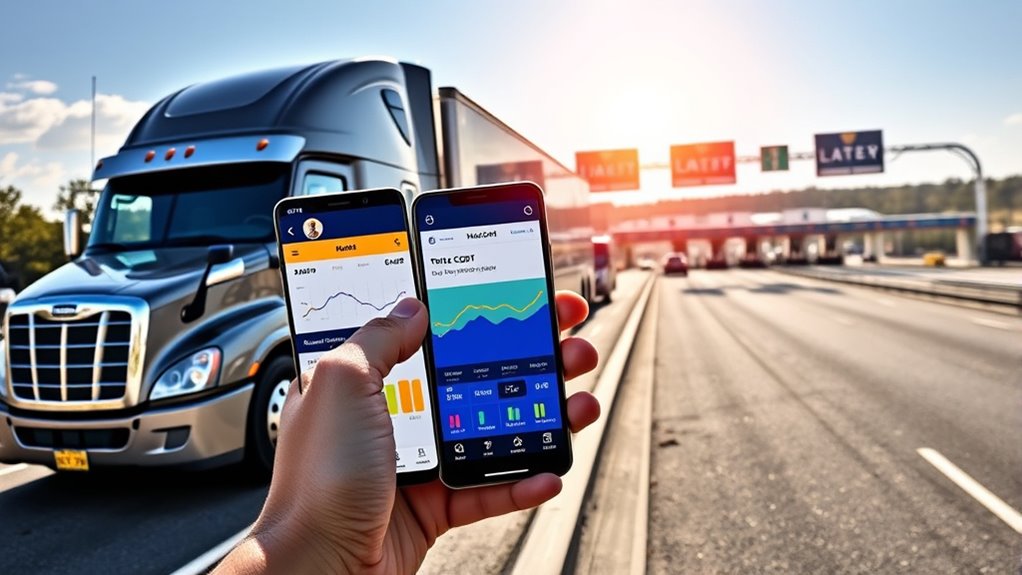
Estimating toll costs for commercial vehicles and RVs requires careful consideration of vehicle size, weight, and travel routes. Larger vehicles often face different toll fee policies, which can vary by state or region, impacting overall costs. Understanding how toll collection systems operate is essential, as some may charge based on axle count, vehicle classification, or distance traveled. Accurate route planning helps you anticipate toll charges, especially on highways with multiple toll points. Keep in mind that toll rates for commercial vehicles and RVs tend to be higher than for passenger cars, reflecting their size and weight. By researching specific toll policies and systems along your route, you can better estimate expenses and avoid surprises when crossing toll roads.
Considering Toll Passes and Electronic Transponders

Considering toll passes and electronic transponders can streamline your toll payments and save you money. Different types of passes are available, each offering specific benefits based on your travel needs. Using an electronic transponder makes toll tracking easier and reduces the risk of missed or late payments.
Types of Toll Passes
Toll passes and electronic transponders are essential tools for steering toll roads efficiently. Understanding the different toll pass types helps you choose the best option for your trip. First, there are prepaid toll passes, which you load with funds in advance, ensuring quick passage and avoiding stopping at toll booths. Second, transponder-based passes use an electronic transponder that communicates with toll systems, simplifying toll collection. Third, some regions offer pay-as-you-go options, where you’re billed after your trip, providing flexibility without upfront costs. Knowing which toll pass types are available helps you avoid delays and unexpected charges. When selecting a toll pass, consider your travel routes and frequency to determine whether a specific electronic transponder or prepaid pass best fits your needs.
Electronic Transponder Benefits
Electronic transponders streamline the toll payment process by allowing vehicles to pass through toll points without stopping. This convenience improves toll collection methods, reducing congestion and wait times. When using an electronic transponder, you don’t need to worry about toll booth etiquette, such as slowing down or stopping at cash lanes. Instead, your transponder automatically deducts the toll fee, making your drive smoother. Plus, managing toll costs becomes easier, as you can track your charges online or through apps. Many toll agencies offer discounts for transponder users, saving you money over cash payments. Remember, keeping your transponder properly mounted and ensuring your account is funded helps avoid unnecessary toll violations. Overall, electronic transponders make toll journeys faster, more efficient, and hassle-free.
Budgeting for Unexpected Toll Expenses

Have you ever been caught off guard by an unexpected toll charge that threw off your travel budget? To prevent surprises, consider planning for unexpected toll expenses. First, understand toll fee policies in the areas you’ll visit, as rates and payment methods vary. Second, keep in mind that toll booth maintenance can cause delays or additional fees if equipment isn’t functioning properly. Third, allocate a buffer amount in your budget—around 10-15% of your estimated toll costs—to cover unforeseen charges. Staying informed about toll fee policies helps you avoid surprises, while awareness of toll booth maintenance issues ensures smoother travel. By planning ahead, you can manage unexpected toll expenses confidently and keep your trip on track financially.
Tips for Avoiding Toll Roads When Possible
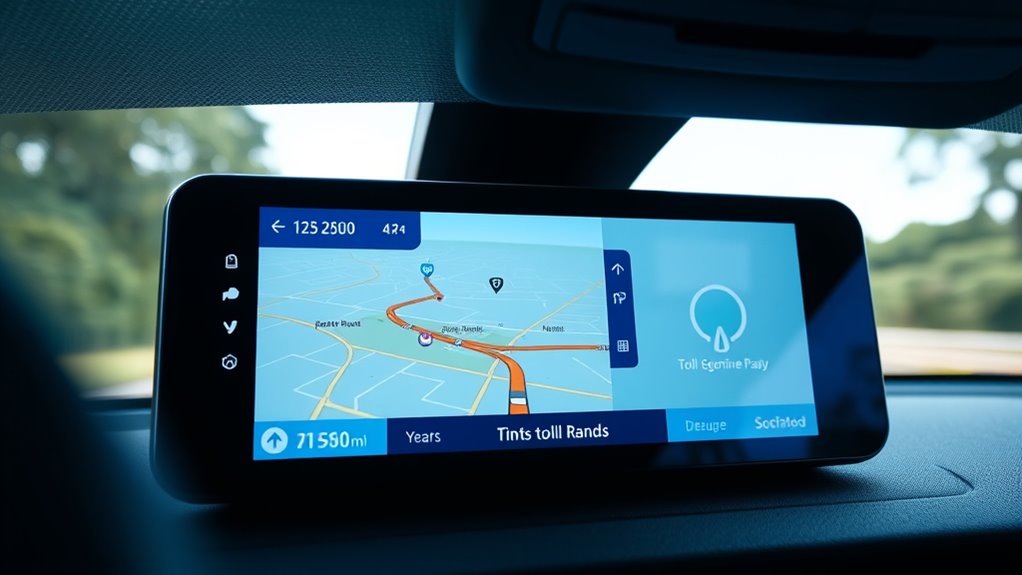
To minimize your toll expenses, it’s smart to choose routes that bypass toll roads whenever possible. Use maps or navigation apps to identify alternative roads that don’t charge toll fees. Planning ahead can help you avoid toll fee discounts that are often available only on certain routes. Additionally, familiarize yourself with different toll payment methods, such as electronic transponders, toll passes, or cash, to streamline your journey and prevent unnecessary delays. Some apps even suggest toll-free routes based on your preferences. By proactively selecting routes and understanding your toll payment options, you can considerably reduce your toll costs and avoid surprises on your trip. Being strategic about your route choices ensures you save money and enjoy a smoother, more predictable travel experience.
Staying Informed About Toll Changes and Updates
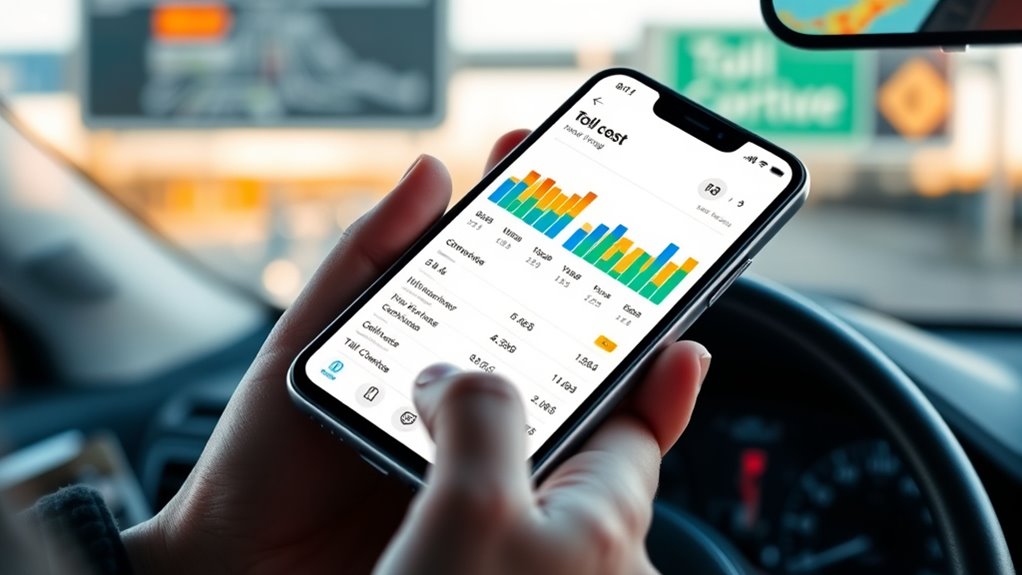
Staying informed about toll changes and updates is essential for managing your travel costs effectively. Regulations and toll rates can change frequently, so keeping up-to-date prevents surprises. To do this:
- Regularly check official transportation websites for updates on toll payment methods and fee adjustments.
- Pay attention to toll booth signage, which can indicate new payment options or lane changes.
- Use mobile apps or GPS systems that provide real-time alerts about toll updates and alternative routes.
Being aware of these changes helps you choose the most cost-effective toll payment methods and avoid unnecessary fees. Staying informed guarantees a smoother journey and better control over your toll expenses.
Frequently Asked Questions
How Often Do Toll Rates Typically Change Across Different States?
Toll rates typically change based on state by state toll policies, and the frequency varies. Some states adjust rates annually or semi-annually, while others update them less frequently, such as every few years. You should stay informed about toll rate adjustments by checking official transportation websites or toll operators. This way, you can plan your budget accordingly and avoid surprises when crossing different states with varying toll policies.
Are There Any Toll Discounts for Frequent Travelers?
Imagine your journey as a road with hidden treasures—discount programs await frequent travelers like you. Many states offer loyalty discounts or toll pass programs, turning your regular tolls into savings. By signing up for these programs, you gain access to benefits that reduce costs over time. Keep an eye on local options, and you’ll find that consistent travelers often enjoy significant discounts, making each trip smoother and more affordable.
Can I Dispute a Toll Charge I Believe Is Incorrect?
If you believe a toll charge is incorrect, you can file a toll dispute with the relevant agency. Start by reviewing the toll details and gather evidence, like photos or receipts. Contact the toll authority promptly to request a charge correction. Be clear and concise in explaining your case. Most agencies have a process for toll dispute resolution, and acting quickly improves your chances of a successful charge correction.
What Are the Best Strategies for Avoiding Tolls During Peak Hours?
To avoid tolls during peak hours, you should plan alternative routes that bypass toll plazas, especially during busy times. Use navigation apps to find toll-free options and real-time traffic updates, helping you stay on less congested roads. Traveling during off-peak hours can also reduce toll costs and delays. By combining alternative routes with toll-free options, you make your trip smoother and more cost-effective.
How Do Toll Costs Vary Between Peak and Off-Peak Travel Times?
You’ll notice toll costs often fluctuate due to dynamic pricing, which adjusts rates based on demand. During peak hours, toll rate fluctuations cause prices to rise, encouraging less congestion. Off-peak times usually feature lower toll rates, helping you save money. By understanding these patterns, you can plan your trips accordingly to avoid higher costs, making your travel more affordable and less stressful.
Conclusion
By planning ahead and staying informed, you can effectively manage toll costs and avoid surprises on the road. Did you know that tolls can account for up to 30% of a road trip’s total expenses? Using online tools, apps, and route planning helps you save money and reduce stress. Keep an eye on toll updates, and consider toll passes to make your journeys smoother and more affordable.








